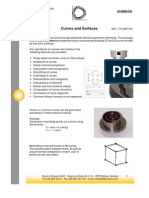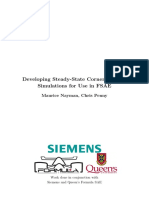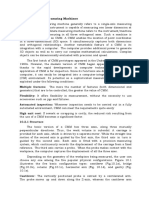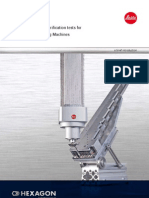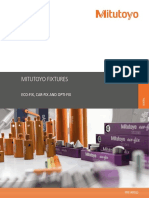Coordinate Measuring Machine: Navyatej
Coordinate Measuring Machine: Navyatej
Uploaded by
Navya Tej MCopyright:
Available Formats
Coordinate Measuring Machine: Navyatej
Coordinate Measuring Machine: Navyatej
Uploaded by
Navya Tej MOriginal Description:
Original Title
Copyright
Available Formats
Share this document
Did you find this document useful?
Is this content inappropriate?
Copyright:
Available Formats
Coordinate Measuring Machine: Navyatej
Coordinate Measuring Machine: Navyatej
Uploaded by
Navya Tej MCopyright:
Available Formats
COORDINATE MEASURING MACHINE
Manufacturing and metrology lab report
NavyaTej
Me10b021
Aim: To measure the geometric parameters of the given block. Apparatus Required: Coordinate Measuring Machine (CMM), Geomet software, widget block, probe, probe fixture. Procedure: Step1: Connect system with CMM and calibrate the ruby ball stylus using the calibration ball.
Step2: Generally the origin is fixed at back end of the horizontal surface of machine. Step3: But if we want to change the origin we can change it using the software. It will measure all the readings from origin. Step4: We have been given the plate as shown in figure for finding its dimensions using stylus. Step5: We will have a remote to control the motion of the stylus and. Step6: If you want to measure thickness, you can touch the stylus probe at any point of the upper surface and take a lower surface point also and get the distance between those. Step7: If you want to measure the radius of a circle, then take three points of the circle using stylus and you can get the radius of the circle. Step8: To get angle of an inclined surface, take three points on the plane and form a plane, after that measure angle using angle option in the software between the plane and already formed horizontal plane or with respect to which plane required. Step8: After getting total dimensions we can get the geometry of the object in type of CAD model. Theory: A Coordinate Measuring Machine (CMM) is an instrument that locates point coordinates on three dimensional structures mainly used for quality control applications. The highly sensitive machine measures parts down to the fraction of an inch and must be properly maintained and protected to ensure accurate measurements. Specifically, a CMM contains many highly sensitive air bearings on which the measuring arm floats.
The typical 3 "bridge" CMM is composed of three axes, an X, Y and Z. These axes are orthogonal to each other in a typical three dimensional coordinate system. Each axis has a scale system that indicates the location of that axis. The machine will read the input from the touch probe, as directed by the operator or programmer. The machine then uses the X, Y, Z coordinates of each of these points to determine size and position with micrometer precision typically. Dimensional inspection is used in process control; its results adjust the parameters of the manufacturing process to achieve the desired outputs. Computer controlled dimensional inspection is typically performed with a Coordinate Measuring Machine or CMM, which is a very precise mechanical system designed to move a measuring probe to determine coordinates of points on a work piece surface.
A CMM consists of a workspace in which parts are fixed, a sensor for detecting the part surfaces, a mechanical assembly for moving the part sensor around the workspace, and a computer with software used in calculating the part dimensions based on the sensor measurements. CMM has a touch-trigger probe, which uses a ruby-tipped stylus to sense the part.
Figure showing typical CMM
When taking a measurement, the stylus is brought into contact with a part surface. By probing the part on its critical surfaces and recording their locations, the dimensions of the part can be calculated. The computer software (Geomet) will maintain a database of qualified styli used in an inspection report. Each stylus that will be used in the report needs to be qualified against a known reference sphere to identify the size and MCS (machine coordinate system) location of the reference. Features of machine: In the CMM experiment the following feature controls: angularity, parallelism, perpendicularity, and flatness are inspected. In modern machines, the gantry type superstructure has two legs and is often called a bridge. This moves freely along the granite table with one leg (often referred to as the inside leg) following a guide rail attached to one side of the granite table. The opposite leg (often outside leg) simply rests on the granite table following the vertical surface contour. Working principle: Air bearings are the chosen method for ensuring friction free travel. In these, compressed air is forced through a series of very small holes in a flat bearing surface to provide a smooth but controlled air cushion on which the CMM can move in a frictionless manner. The movement of the bridge or gantry along the granite table forms one axis of the XY plane. The bridge of the gantry contains a carriage which traverses between the inside and outside legs and forms the other X or Y horizontal axis. The third axis of movement (Z axis) is provided by the addition of vertical quill or spindle which moves up and down through the center of the carriage. The touch probe forms the sensing device on the end of the quill. The movement of the X, Y and Z axes fully describes the measuring envelope. Optional rotary tables can be used to enhance the approachability of the measuring probe to complicated work pieces. The rotary table as a fourth drive axis does not enhance the measuring dimensions, which remain 3D, but it does provide a degree of flexibility. Some touch probes are themselves powered rotary devices with the probe tip able to swivel vertically through 90 degrees and through a full 360 degree rotation. Applications: Some of the applications are as shown:
Learning: To measure the different dimensions of an object using CMM and its software package.
Calibration of CMM using standard ceramic ball.
You might also like
- Basics of The CMM 120Document4 pagesBasics of The CMM 120cqi9n100% (1)
- Coordinate Measuring MachineDocument13 pagesCoordinate Measuring MachineAjay G RNo ratings yet
- Calypso: Option 8 Rds-CaaDocument26 pagesCalypso: Option 8 Rds-CaaGabriel TelepteanNo ratings yet
- Quindos BrochureDocument33 pagesQuindos Brochuredipak5939No ratings yet
- Developing Steady-State Cornering CFD Simulations For Use in FSAEDocument11 pagesDeveloping Steady-State Cornering CFD Simulations For Use in FSAEKiệt LêNo ratings yet
- H-1000-5301-01-A Creating A New Environment, Tools and Calibration of Tools Using UCCserver V4.5Document22 pagesH-1000-5301-01-A Creating A New Environment, Tools and Calibration of Tools Using UCCserver V4.5Jesus MedinaNo ratings yet
- Hexagon MI GLOBAL S DataSheet Letter EN NAFTA Rel5Document22 pagesHexagon MI GLOBAL S DataSheet Letter EN NAFTA Rel5dudecastro1542No ratings yet
- Co-Ordinate Measuring Machine: Metereology & Machining LabDocument4 pagesCo-Ordinate Measuring Machine: Metereology & Machining LabSumit JadhavNo ratings yet
- Practical No 10Document4 pagesPractical No 10Muhammad JahanzaibNo ratings yet
- Btm2133-Chapter 9 CMMDocument35 pagesBtm2133-Chapter 9 CMMAswaja313No ratings yet
- Coordinate Measuring Machine (CMM)Document21 pagesCoordinate Measuring Machine (CMM)info_azeet100% (1)
- 10.2 Coordinate Measuring MachinesDocument6 pages10.2 Coordinate Measuring MachinesVenkateshYadavCivarlaNo ratings yet
- Module Iv: Computer Aided and Laser Metrology:: The Upright With Carrying Arm, and The Sighting MicroscopeDocument9 pagesModule Iv: Computer Aided and Laser Metrology:: The Upright With Carrying Arm, and The Sighting MicroscopeShiba SahuNo ratings yet
- Coordinate Measuring Machine (CMM)Document67 pagesCoordinate Measuring Machine (CMM)nurul aini0% (1)
- Co-Ordinate Measuring Machines & It's Applications: Introduction ToDocument65 pagesCo-Ordinate Measuring Machines & It's Applications: Introduction Toshiva dNo ratings yet
- Coordinate Measuring Machine (CMM)Document31 pagesCoordinate Measuring Machine (CMM)nurul ainiNo ratings yet
- Coordinate MeasuringDocument9 pagesCoordinate MeasuringRadin HazimahNo ratings yet
- Quindos Gear Gauges: Messtechnik Wetzlar GMBH 35578 Wetzlar, GermanyDocument1 pageQuindos Gear Gauges: Messtechnik Wetzlar GMBH 35578 Wetzlar, GermanyKOMATSU SHOVELNo ratings yet
- BasicCAM2 SmartInspect Basic v1.2 - FaroArm and FARO Gage Training Workbook - November 2014Document166 pagesBasicCAM2 SmartInspect Basic v1.2 - FaroArm and FARO Gage Training Workbook - November 2014raseen pNo ratings yet
- Hexagon MI 7107 SF Brochure A4 ENDocument6 pagesHexagon MI 7107 SF Brochure A4 ENAna Gabriela OjedaNo ratings yet
- Quindos Gear PTB Certified: Messtechnik Wetzlar GMBH 35578 Wetzlar, GermanyDocument1 pageQuindos Gear PTB Certified: Messtechnik Wetzlar GMBH 35578 Wetzlar, GermanyKOMATSU SHOVELNo ratings yet
- ETSE Zeiss Strategy1Document20 pagesETSE Zeiss Strategy1cmm5477No ratings yet
- Calypso: Improved AI FunctionDocument11 pagesCalypso: Improved AI FunctionRicardo Núñez100% (1)
- MAP 1302 4 MCOSMOS E16008 4 LR f895bdb81f PDFDocument28 pagesMAP 1302 4 MCOSMOS E16008 4 LR f895bdb81f PDFMichael CabreraNo ratings yet
- Apply Datum Shift in CMM Software HTTPDocument3 pagesApply Datum Shift in CMM Software HTTPAnonymous 7ZTcBnNo ratings yet
- Wenzel Technical Data Sheet LH 1210 1512 Premium SelectDocument4 pagesWenzel Technical Data Sheet LH 1210 1512 Premium SelectBoris 'Junior' BorisovNo ratings yet
- Quindos Unknown Gear: Messtechnik Wetzlar GMBH 35578 Wetzlar, GermanyDocument1 pageQuindos Unknown Gear: Messtechnik Wetzlar GMBH 35578 Wetzlar, GermanyKOMATSU SHOVELNo ratings yet
- 08 - Measurements, Inspection Principles and CMMDocument38 pages08 - Measurements, Inspection Principles and CMMBhartendu TavriNo ratings yet
- Leitz Iso10360 IntroductionDocument16 pagesLeitz Iso10360 Introductioncpo_cpoNo ratings yet
- 489 33 Powerpoint-Slides 9Document17 pages489 33 Powerpoint-Slides 9Randøm Talkìês100% (1)
- En 60 020 0002iii Zeiss O-Inspect PDFDocument20 pagesEn 60 020 0002iii Zeiss O-Inspect PDFNPD TechnoringsNo ratings yet
- Software PolyWorks V12 Inspector Airfoil Gauge Module enDocument2 pagesSoftware PolyWorks V12 Inspector Airfoil Gauge Module entheflamebearerNo ratings yet
- Lab 1C - Cranked Styli - Multi Spheres (H-1000-5335-01-A) SPDocument18 pagesLab 1C - Cranked Styli - Multi Spheres (H-1000-5335-01-A) SPadolfoNo ratings yet
- Cmm-Manager: Fully Featured Metrology Software For Multi-Sensor, CNC, Manual, and Portable CmmsDocument8 pagesCmm-Manager: Fully Featured Metrology Software For Multi-Sensor, CNC, Manual, and Portable CmmsSzymonNo ratings yet
- Calypso Maquina de CoordenadasDocument16 pagesCalypso Maquina de CoordenadasIvonne LunaNo ratings yet
- 2170 McosmosDocument12 pages2170 McosmosNguyễn HòaNo ratings yet
- Camio8: Multi-Sensor CMM SoftwareDocument16 pagesCamio8: Multi-Sensor CMM SoftwareJorge OliveiraNo ratings yet
- 04 - ALL - Feature FittingDocument33 pages04 - ALL - Feature FittingBeNjaz NorthcuttNo ratings yet
- TESA Catalogue 2010Document449 pagesTESA Catalogue 2010Biser BorislawowNo ratings yet
- 24 - Reporting Measurement ResultsDocument388 pages24 - Reporting Measurement Resultssokaiya ramanNo ratings yet
- Mitutoyo Komeg - System Mocowania Eco-Fix, Car-Fix I Opti-Fix - PRE1403 (2) - 2013 ENDocument80 pagesMitutoyo Komeg - System Mocowania Eco-Fix, Car-Fix I Opti-Fix - PRE1403 (2) - 2013 END.T.No ratings yet
- Calypso 127 True Position With Zeiss Calypso Part 3Document1 pageCalypso 127 True Position With Zeiss Calypso Part 3ferinoNo ratings yet
- Coordinates Measuring Machines (CMM)Document20 pagesCoordinates Measuring Machines (CMM)Muthu RajNo ratings yet
- Global Classic: Cost-Effective, All-Purpose Bridge CMMDocument12 pagesGlobal Classic: Cost-Effective, All-Purpose Bridge CMMMauricio SilvaNo ratings yet
- Section 4 Slides 2022Document140 pagesSection 4 Slides 2022Sathappan Kasi100% (1)
- Coordinate Measuring MachineDocument20 pagesCoordinate Measuring MachineDevadattNo ratings yet
- Calypso 08 RdscaaDocument22 pagesCalypso 08 RdscaaDragu StelianNo ratings yet
- DU BushesDocument56 pagesDU BushesBlashko GjorgjievNo ratings yet
- 03 - ALL - PCS and Part ProgrammingDocument12 pages03 - ALL - PCS and Part ProgrammingBeNjaz NorthcuttNo ratings yet
- MCOSMOS Software BulletinDocument16 pagesMCOSMOS Software BulletinYnomata RusamellNo ratings yet
- 27 - Using Expressions and VariablesDocument94 pages27 - Using Expressions and Variablessokaiya ramanNo ratings yet
- Angular Measurement MetallurgyDocument19 pagesAngular Measurement MetallurgyMonojit KonarNo ratings yet
- CMMDocument1 pageCMMTradiyo ForexNo ratings yet
- Mcosmos E4180 525Document28 pagesMcosmos E4180 525Biljana UšćumlićNo ratings yet
- 1) Coordinate Measuring MachineDocument12 pages1) Coordinate Measuring MachineBintang PaningitNo ratings yet
- CMMMMDocument6 pagesCMMMMMuhamad HafizNo ratings yet
- Coordinate Measuring MachineDocument5 pagesCoordinate Measuring MachineMuhammad UsmanNo ratings yet
- Presentation On CMMDocument17 pagesPresentation On CMMSonu Sharma100% (1)
- Theoretical method to increase the speed of continuous mapping in a three-dimensional laser scanning system using servomotors controlFrom EverandTheoretical method to increase the speed of continuous mapping in a three-dimensional laser scanning system using servomotors controlNo ratings yet



